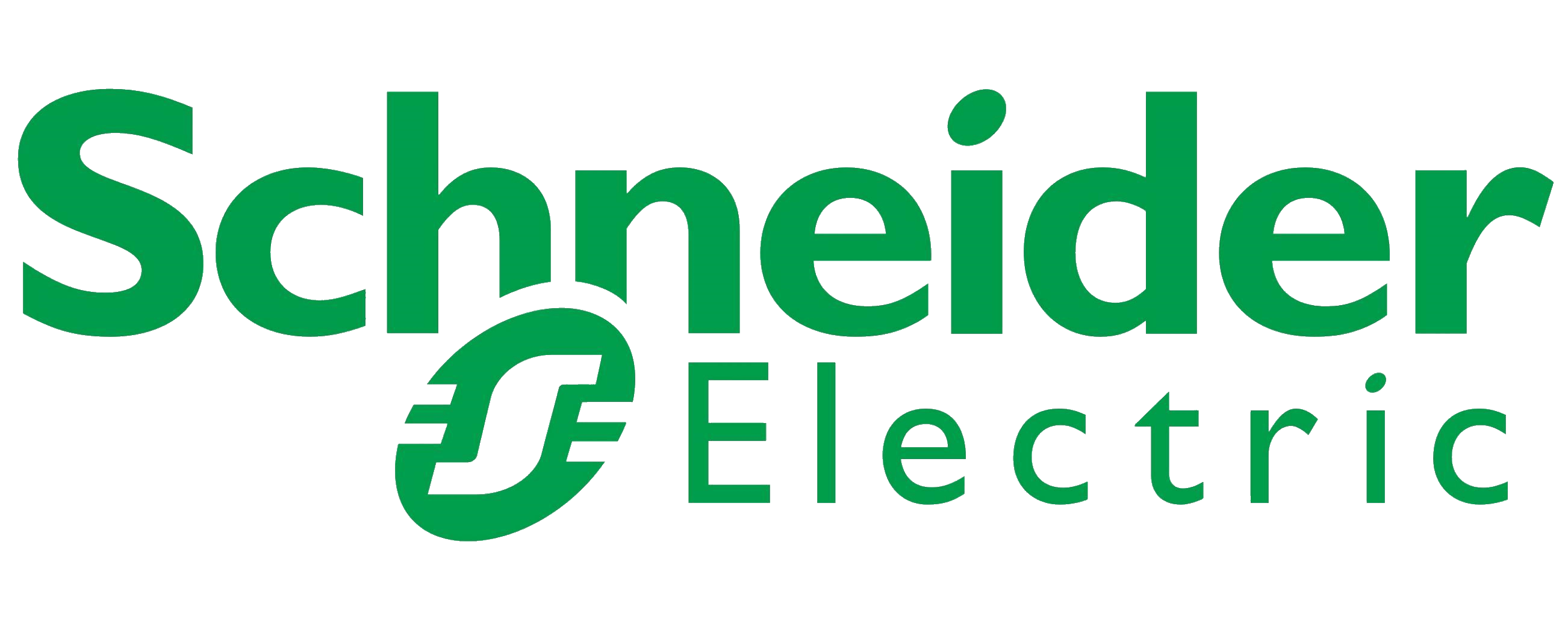Global Green Building Materials Market, By Type, By Application, By End User, By Region, & Segmental Insights Trends and Forecast, 2024 – 2034
- Industry: Construction & Manufacturing
- Report ID: TNR-110-1294
- Number of Pages: 420
- Table/Charts : Yes
- September, 2024
- Base Year : 2024
- No. of Companies : 10+
- No. of Countries : 29
- Views : 10037
- Covid Impact Covered: Yes
- War Impact Covered: Yes
- Formats : PDF, Excel, PPT
Green building materials are environmentally friendly products used in construction that minimize resource consumption, reduce environmental impact, and promote sustainability. These materials include recycled steel, bamboo, and energy-efficient insulation, among others. The global green building materials market is expanding rapidly, driven by the growing demand for sustainable construction practices. These materials are widely used in residential, commercial, and industrial buildings, contributing to energy efficiency, improved indoor air quality, and reduced carbon footprints.
Applications range from structural components like recycled steel and sustainable wood to exterior products such as green roofs and energy-efficient windows. The adoption of green building materials is crucial in developing sustainable urban infrastructure, promoting eco-friendly construction, and addressing global environmental challenges. In Terms of Revenue, the Global Green Building Materials Market was Worth US$ 421.5 Bn in 2023, Anticipated to Witness CAGR of 11.8% During 2024 – 2034.
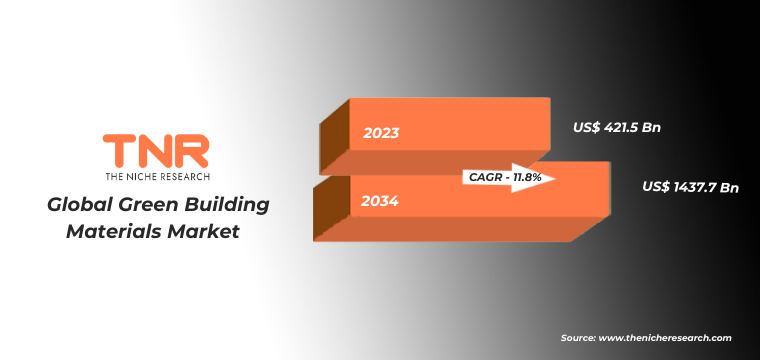
Growth Drivers of Global Green Building Materials Market
- Government Regulations and Incentives: Many countries have implemented stringent building codes and standards that mandate the use of sustainable materials to enhance energy efficiency and reduce environmental impact. These regulations encourage builders and developers to adopt green materials, fostering market growth. Additionally, financial incentives such as tax credits, grants, and rebates for green building projects further stimulate demand. By creating a favorable regulatory environment and offering financial benefits, governments effectively promote the use of eco-friendly materials, driving the expansion of the green building materials market.
- Increasing Consumer Awareness and Demand: As individuals become more conscious of their carbon footprint and the environmental impact of their choices, they increasingly demand eco-friendly building solutions. This heightened awareness leads to a preference for green building materials that offer benefits such as energy efficiency, improved indoor air quality, and reduced environmental harm. This consumer-driven demand is reflected in both residential and commercial construction projects, prompting builders and developers to integrate sustainable materials into their designs. Consequently, the rise in consumer demand fuels market growth for green building materials.
Need of Green Buildings and Widely Used Material in Green Building:
Buildings account for 40% of global energy consumption and material use, making them a leading source of greenhouse gas emissions, surpassing even the transportation and industrial sectors. During the construction of a typical 2,000-square-foot home, about 8,000 pounds of waste are often sent to landfills. In the U.S., buildings use over twice the energy consumed by all vehicles and represent 68% of total electricity use. They also account for 80% of the nation’s drinking water consumption. Additionally, indoor pollution levels are frequently 2 to 5 times higher than outdoor levels.
Widely used materials in green building include recycled steel, bamboo, and sustainable wood. These materials offer energy efficiency, reduced environmental impact, and enhanced sustainability. Others, like low-VOC paints and energy-efficient insulation, contribute to healthier indoor environments and lower energy consumption, supporting eco-friendly and sustainable construction practices.

Exterior by type category have emerged as a dominant segment in the global green building materials market capturing a revenue share of 37.9% in 2023. This prominence reflects the crucial role these materials play in enhancing the sustainability of buildings. Exterior green materials, such as energy-efficient roofing, eco-friendly siding, and sustainable windows, contribute to improved thermal performance, reduced energy consumption, and better overall environmental impact. These materials are vital for creating energy-efficient buildings that minimize heat loss and manage solar gain. Applications include residential homes, commercial properties, and public infrastructure, where they help in achieving green building certifications and meeting stringent environmental standards.
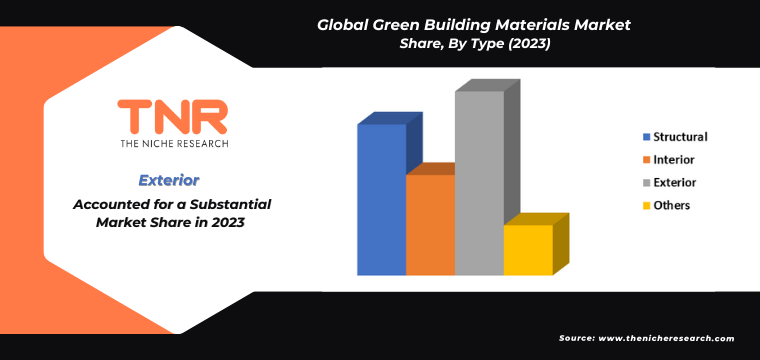
In 2023, roofing segment solidified its position as the second-largest application category within the global green building materials market with revenue share of 23.6%. Roofing materials are crucial for enhancing a building’s energy efficiency and environmental performance. Green roofing options, such as reflective and cool roofs, green roofs, and sustainably sourced materials, help in reducing heat absorption, improving insulation, and managing stormwater. These benefits contribute to lower energy consumption, reduced urban heat islands, and improved building longevity. The increasing adoption of green roofing solutions across residential, commercial, and industrial applications highlights their growing importance in achieving sustainable construction and environmental goals.

Green building materials are predominantly used in non-residential applications, such as commercial, industrial, and public infrastructure projects. This trend is driven by the substantial environmental impact and operational costs associated with large-scale buildings and facilities. Non-residential structures often have higher energy consumption and greater environmental footprints, making the adoption of sustainable materials essential for reducing these impacts. Green building materials, such as energy-efficient windows, sustainable roofing, and advanced HVAC systems, help improve energy efficiency, enhance indoor air quality, and lower operational costs. Their use in non-residential projects not only supports environmental goals but also meets regulatory standards and achieves long-term cost savings, leading to their increased adoption in these sectors.
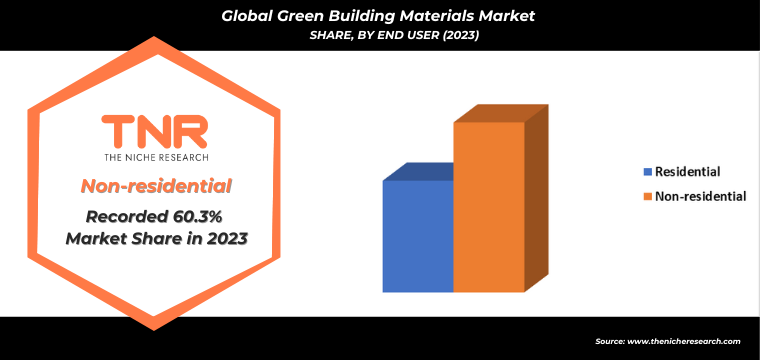
In 2023, Europe is set to solidified its dominance in the global green building materials market, contributing a revenue share of 21.1%. This leadership is attributed to Europe’s stringent environmental regulations, ambitious sustainability goals, and robust green building initiatives. European countries are at the forefront of adopting and promoting eco-friendly building practices, driven by policies aimed at reducing carbon emissions and enhancing energy efficiency. The region’s commitment to sustainable construction and innovations in green materials has established it as a major player in the market, influencing global trends and setting benchmarks for environmentally responsible building practices.
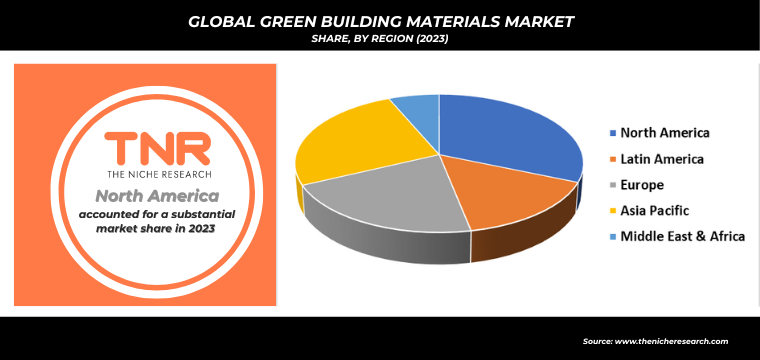
Competitive Landscape
Some of the players operating in the green building materials market are
- Alumasc Group plc.
- BASF SE
- Bauder Ltd.
- Binderholz GmbH
- CertainTeed Corporation
- Forbo International SA
- Holcim
- Homasote Company
- Kingspan Limited
- Lafarge Company
- LG Hausys Ltd.
- PPG Industries, Inc.
- RedBuilt LLC
- Saint-Gobain
- Sika AG
- Wienerberger AG
- Other Industry Participants
Manufacturers in the global green building materials market are focusing on innovation and collaboration to stay competitive. They are partnering with other companies to enhance product offerings and expand their market presence. Key strategies include developing new eco-friendly materials and integrating advanced technologies. Recent launches highlight their commitment to sustainability, offering solutions that meet stringent environmental standards and address the growing demand for green construction practices.
- In November 2020, U.K.-based Lhoist introduced Tradical Hemcrete, an eco-friendly and energy-efficient building material made from a blend of hemp wood, water, and lime. Tradical Hemcrete, which is recyclable, is used for constructing walls and renovating older buildings as an insulating solution.
- In May 2020, RedBuilt and SmartLam North America announced a partnership to provide Cross Laminated Timber (CLT) solutions. This collaboration will enable engineers, contractors, and architects to access mass timber building technology. RedBuilt will exclusively distribute SmartLam CLT across the West Coast, Pacific Northwest, and Southwest regions.
Global Green Building Materials Market Scope:
| Report Specifications | Details |
| Market Revenue in 2023 | US$ 421.5 Bn |
| Market Size Forecast by 2034 | US$ 1437.7 Bn |
| Growth Rate (CAGR) | 11.8% |
| Historic Data | 2016 – 2022 |
| Base Year for Estimation | 2023 |
| Forecast Period | 2024 – 2034 |
| Report Inclusions | Market Size & Estimates, Market Dynamics, Competitive Scenario, Trends, Growth Factors, Market Determinants, Key Investment Segmentation, Product/Service/Solutions Benchmarking |
| Segments Covered | By Type, By Application, By End User, By Region |
| Regions Covered | North America, Europe, Asia Pacific, Middle East & Africa, Latin America |
| Countries Covered | U.S., Canada, Mexico, Rest of North America, France, The UK, Spain, Germany, Italy, Nordic Countries (Denmark, Finland, Iceland, Sweden, Norway), Benelux Union (Belgium, The Netherlands, Luxembourg), Rest of Europe, China, Japan, India, New Zealand, Australia, South Korea, Southeast Asia (Indonesia, Thailand, Malaysia, Singapore, Rest of Southeast Asia), Rest of Asia Pacific, Saudi Arabia, UAE, Egypt, Kuwait, South Africa, Rest of Middle East & Africa, Brazil, Argentina, Rest of Latin America |
| Key Players | Alumasc Group plc., BASF SE, Bauder Ltd., Binderholz GmbH, CertainTeed Corporation, Forbo International SA, Holcim, Homasote Company, Kingspan Limited, Lafarge Company, LG Hausys Ltd., PPG Industries, Inc., RedBuilt LLC, Saint-Gobain, Sika AG, Wienerberger AG |
| Customization Scope | Customization allows for the inclusion/modification of content pertaining to geographical regions, countries, and specific market segments. |
| Pricing & Procurement Options | Explore purchase options tailored to your specific research requirements |
| Contact Details | Consult With Our Expert
Japan (Toll-Free): +81 663-386-8111 South Korea (Toll-Free): +82-808- 703-126 Saudi Arabia (Toll-Free): +966 800-850-1643 United Kingdom: +44 753-710-5080 United States: +1 302-232-5106 E-mail: askanexpert@thenicheresearch.com
|
Global Green Building Materials Market
By Type
- Structural
- Interior
- Exterior
- Others
By Application
- Roofing
- Flooring
- Insulation
- Others
By End User
- Residential
- Non-residential
By Region
- North America (U.S., Canada, Mexico, Rest of North America)
- Europe (France, The UK, Spain, Germany, Italy, Nordic Countries (Denmark, Finland, Iceland, Sweden, Norway), Benelux Union (Belgium, The Netherlands, Luxembourg), Rest of Europe)
- Asia Pacific (China, Japan, India, New Zealand, Australia, South Korea, Southeast Asia (Indonesia, Thailand, Malaysia, Singapore, Rest of Southeast Asia), Rest of Asia Pacific)
- Middle East & Africa (Saudi Arabia, UAE, Egypt, Kuwait, South Africa, Rest of Middle East & Africa)
- Latin America (Brazil, Argentina, Rest of Latin America)
Report Layout:
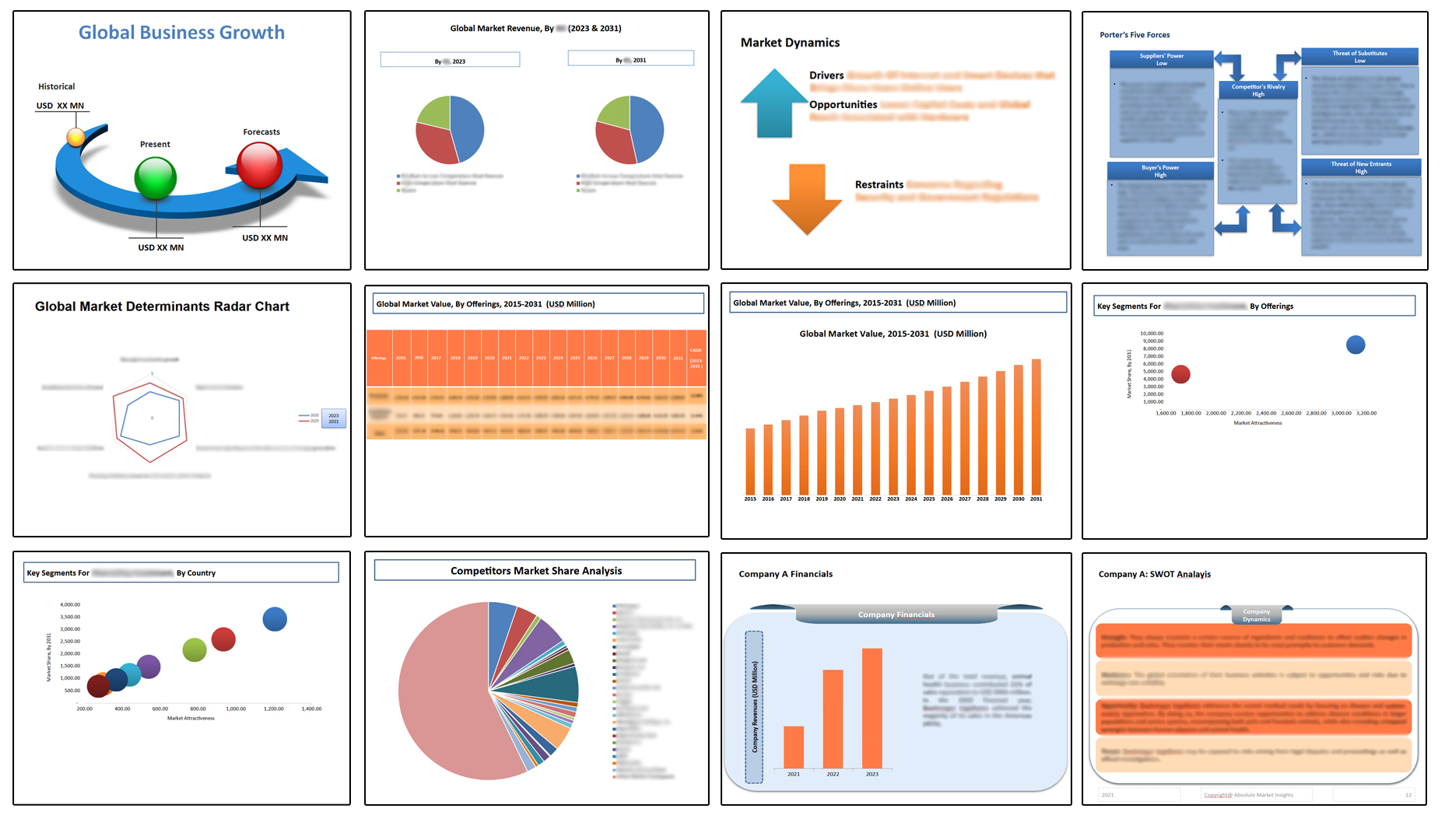
Table of Contents
Note: This ToC is tentative and can be changed according to the research study conducted during the course of report completion.
**Exclusive for Multi-User and Enterprise User.
Global Green Building Materials Market
By Type
- Structural
- Interior
- Exterior
- Others
By Application
- Roofing
- Flooring
- Insulation
- Others
By End User
- Residential
- Non-residential
By Region
- North America (U.S., Canada, Mexico, Rest of North America)
- Europe (France, The UK, Spain, Germany, Italy, Nordic Countries (Denmark, Finland, Iceland, Sweden, Norway), Benelux Union (Belgium, The Netherlands, Luxembourg), Rest of Europe)
- Asia Pacific (China, Japan, India, New Zealand, Australia, South Korea, Southeast Asia (Indonesia, Thailand, Malaysia, Singapore, Rest of Southeast Asia), Rest of Asia Pacific)
- Middle East & Africa (Saudi Arabia, UAE, Egypt, Kuwait, South Africa, Rest of Middle East & Africa)
- Latin America (Brazil, Argentina, Rest of Latin America)
The Niche Research approach encompasses both primary and secondary research methods to provide comprehensive insights. While primary research is the cornerstone of our studies, we also incorporate secondary research sources such as company annual reports, premium industry databases, press releases, industry journals, and white papers.
Within our primary research, we actively engage with various industry stakeholders, conducting paid interviews and surveys. Our meticulous analysis extends to every market participant in major countries, allowing us to thoroughly examine their portfolios, calculate market shares, and segment revenues.
Our data collection primarily focuses on individual countries within our research scope, enabling us to estimate regional market sizes. Typically, we employ a bottom-up approach, meticulously tracking trends in different countries. We analyze growth drivers, constraints, technological innovations, and opportunities for each country, ultimately arriving at regional figures.Our process begins by examining the growth prospects of each country. Building upon these insights, we project growth and trends for the entire region. Finally, we utilize our proprietary model to refine estimations and forecasts.
Our data validation standards are integral to ensuring the reliability and accuracy of our research findings. Here’s a breakdown of our data validation processes and the stakeholders we engage with during our primary research:
- Supply Side Analysis: We initiate a supply side analysis by directly contacting market participants, through telephonic interviews and questionnaires containing both open-ended and close-ended questions. We gather information on their portfolios, segment revenues, developments, and growth strategies.
- Demand Side Analysis: To gain insights into adoption trends and consumer preferences, we reach out to target customers and users (non-vendors). This information forms a vital part of the qualitative analysis section of our reports, covering market dynamics, adoption trends, consumer behavior, spending patterns, and other related aspects.
- Consultant Insights: We tap into the expertise of our partner consultants from around the world to obtain their unique viewpoints and perspectives. Their insights contribute to a well-rounded understanding of the markets under investigation.
- In-House Validation: To ensure data accuracy and reliability, we conduct cross-validation of data points and information through our in-house team of consultants and utilize advanced data modeling tools for thorough verification.
The forecasts we provide are based on a comprehensive assessment of various factors, including:
- Market Trends and Past Performance (Last Five Years): We accurately analyze market trends and performance data from preceding five years to identify historical patterns and understand the market’s evolution.
- Historical Performance and Growth of Market Participants: We assess the historical performance and growth trajectories of key market participants. This analysis provides insights into the competitive landscape and individual company strategies.
- Market Determinants Impact Analysis (Next Eight Years): We conduct a rigorous analysis of the factors that are projected to influence the market over the next eight years. This includes assessing both internal and external determinants that can shape market dynamics.
- Drivers and Challenges for the Forecast Period:Identify the factors expected to drive market growth during the forecast period, as well as the challenges that the industry may face. This analysis aids in deriving an accurate growth rate projection.
- New Acquisitions, Collaborations, or Partnerships: We keep a close watch on any new acquisitions, collaborations, or partnerships within the industry. These developments can have a significant impact on market dynamics and competitiveness.
- Macro and Micro Factors Analysis:A thorough examination of both macro-level factors (e.g., economic trends, regulatory changes) and micro-level factors (e.g., technological advancements, consumer preferences) that may influence the market during the forecast period.
- End-User Sentiment Analysis: To understand the market from the end-user perspective, we conduct sentiment analysis. This involves assessing the sentiment, preferences, and feedback of the end-users, which can provide valuable insights into market trends.
- Perspective of Primary Participants: Insights gathered directly from primary research participants play a crucial role in shaping our forecasts. Their perspectives and experiences provide valuable qualitative data.
- Year-on-Year Growth Trend: We utilize a year-on-year growth trend based on historical market growth and expected future trends. This helps in formulating our growth projections, aligning them with the market’s historical performance.
Research process adopted by TNR involves multiple stages, including data collection, validation, quality checks, and presentation. It’s crucial that the data and information we provide add value to your existing market understanding and expertise. We have also established partnerships with business consulting, research, and survey organizations across regions and globally to collaborate on regional analysis and data validation, ensuring the highest level of accuracy and reliability in our reports.




